The electronic grade trisilylamine market begins its decade journey from a USD 26.1 million foundation in 2025, setting the stage for steady expansion ahead. The first half of the decade witnesses consistent momentum building, with market value climbing from USD 28.0 million in 2026 to USD 40.2 million by 2030. This initial phase reflects growing semiconductor manufacturing capacity and increasing advanced node production requirements across global foundries.
The latter half will witness growth dynamics, propelling the market from USD 43.2 million in 2031 to reach USD 53.7 million by 2035. Dollar additions during 2030-2035 maintain steady progression, with annual increments averaging USD 2.7 million compared to USD 2.8 million in the first phase. This progression represents a 105.7% total value increase over the forecast decade.
Market maturation factors include expanding semiconductor fab construction, advanced packaging technology adoption, and next-generation device manufacturing requirements. The 7.5% compound annual growth rate positions participants to capitalize on USD 27.6 million in additional market value creation. This trajectory signals robust opportunities for specialty chemical manufacturers, semiconductor material suppliers, and advanced process technology providers across the global electronics manufacturing landscape.
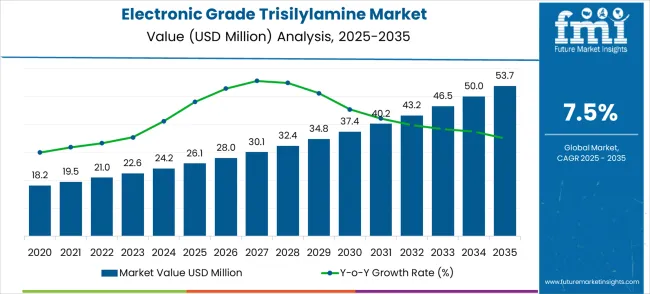
Market expansion unfolds through two distinct growth periods with different technological characteristics for each phase. The 2025-2030 foundation period delivers USD 14.1 million in value additions, representing 54% growth from the baseline. Market dynamics during this phase center on advanced semiconductor node development, CVD process optimization, and purity standard enhancement across manufacturing applications.
The 2030-2035 maturation period generates USD 13.5 million in incremental value, reflecting 33.6% growth from the 2030 position. This phase exhibits mature market characteristics with enhanced competition, advanced process integration strategies, and geographic manufacturing expansion initiatives. Dollar contributions shift from foundational capacity building to advanced technology node requirements and specialized application development.
Competitive landscape evolution progresses from specialty chemical supply to integrated semiconductor material solutions. The first period emphasizes purity advancement and process validation. The second period witnesses intensified competition for premium application segments and comprehensive solution development across CVD, ALD, and emerging semiconductor manufacturing processes.
| Metric | Value |
|---|---|
| Market Value (2025) | USD 26.1 million |
| Market Forecast (2035) | USD 53.7 million |
| Growth Rate | 7.5% CAGR |
| Leading Segment | Purity ≥99.9% |
| Primary Application | CVD |
Market expansion rests on four fundamental shifts driving semiconductor manufacturing material demand acceleration:
The growth faces headwinds from complex synthesis requirements and stringent quality control standards increasing production costs. Limited supplier base creates supply chain concentration risks affecting material availability. Environmental and safety regulations require specialized handling and disposal procedures increasing operational complexity.
The electronic grade trisilylamine market is central to semiconductor manufacturing advancement, advanced node development, device performance, and technological sovereignty. With rapid semiconductor scaling, stringent purity requirements, and geopolitical supply chain concerns, the sector faces pressure to balance ultra-high quality, supply security, and cost competitiveness. Coordinated action from governments, industry bodies, OEMs/technology players, suppliers, and investors is essential to transition toward domestically secure, technologically advanced, and ultra-pure electronic material systems.
How Governments Could Spur Domestic Production and Supply Security?
How Industry Bodies Could Support Market Development?
How OEMs and Technology Players Could Strengthen the Ecosystem?
How Suppliers Could Navigate Technology Evolution?
How Investors and Financial Enablers Could Unlock Value?
Primary Classification: Purity Grade Distribution
Secondary Breakdown: Application Categories
Geographic Segmentation: Regional Market Distribution
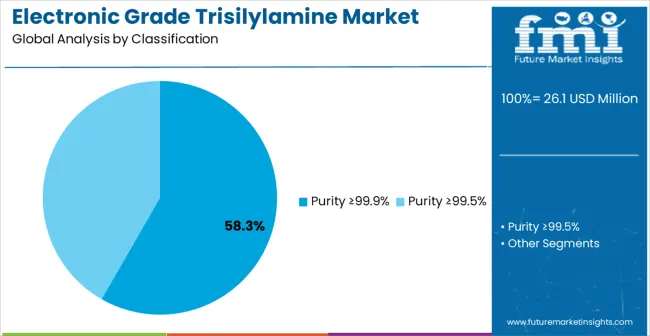
Market Position: Ultra-high purity trisilylamine (≥99.9%) establishes clear market leadership through exceptional contamination control required for advanced semiconductor manufacturing processes. Critical applications including leading-edge logic and memory device production demand the highest material purity to achieve acceptable defect densities. Advanced process nodes below 10nm require ultra-pure precursors to prevent yield-limiting contamination during device fabrication.
Value Drivers: Advanced purification technologies enable consistent impurity control below critical threshold levels affecting device performance and manufacturing yield. Specialized packaging and handling systems maintain material purity throughout supply chain delivery to semiconductor fabs. Quality assurance protocols including comprehensive analytical testing ensure batch-to-batch consistency for critical manufacturing applications.
Competitive Advantages: Ultra-high purity grades offer superior performance in contamination-sensitive applications compared to lower purity alternatives requiring additional purification steps. Process optimization benefits include reduced equipment cleaning requirements and extended process chamber lifetime. Premium applications justify higher material costs through improved device yield and performance characteristics.
Market Challenges: Complex purification requirements increase production costs and technical complexity compared to standard purity grades. Specialized analytical testing and quality control procedures require significant investment in equipment and expertise. Limited production capacity for ultra-pure grades creates supply constraints during peak demand periods.
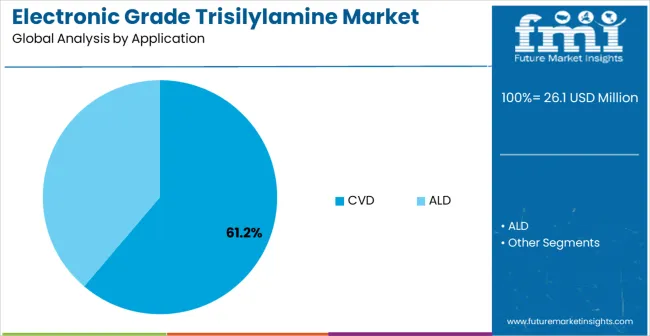
Strategic Market Importance: Chemical Vapor Deposition represents the primary demand driver for electronic grade trisilylamine across semiconductor manufacturing processes. Silicon nitride film deposition for gate dielectrics, spacer formation, and etch stop layers requires precise precursor control achievable through trisilylamine chemistry. Advanced device architectures including FinFET and gate-all-around structures utilize CVD processes for conformal film formation in high-aspect-ratio features.
Market Dynamics Q&A:
Business Logic: Semiconductor manufacturers prioritize process control and device performance, making advanced precursor materials essential for competitive technology development. Material consistency reduces process variation while improving manufacturing yield and device reliability. Investment justification occurs through enhanced device performance and reduced manufacturing costs over product lifecycle.
Forward-looking Implications: Emerging device architectures including chiplet designs and advanced packaging create additional CVD applications requiring specialized precursor materials. Quantum computing and neuromorphic device development may create new application opportunities for ultra-pure trisilylamine. Process technology advancement toward atomic-scale manufacturing increases precision requirements for precursor materials.
Growth Accelerators
Semiconductor industry expansion drives increasing demand for specialized precursor materials supporting advanced device manufacturing processes. Technology node scaling requires ultra-pure materials enabling contamination-free processing essential for acceptable device yield. Fab capacity expansion across global regions creates demand for critical semiconductor materials including electronic grade trisilylamine. Advanced packaging technology adoption necessitates specialized materials for three-dimensional device integration and interconnect formation.
High production costs associated with ultra-pure material synthesis create price pressure affecting adoption in cost-sensitive applications. Limited supplier base concentrates supply chain risks and potential availability constraints during peak demand periods. Complex quality control requirements necessitate significant investment in analytical equipment and specialized expertise. Environmental and safety regulations require specialized handling procedures increasing operational complexity and costs.
Advanced purification technologies enable higher purity grades meeting increasingly stringent semiconductor manufacturing requirements. Process optimization reduces material consumption while maintaining deposition quality and device performance characteristics. Supply chain localization creates regional production capabilities reducing logistics costs and supply chain risks. Digital quality monitoring systems enable real-time process control and predictive maintenance optimization.
Global market dynamics reveal distinct performance tiers reflecting regional semiconductor manufacturing capacity and technology development priorities. High-Growth Markets including China (10.1% CAGR) and India (9.4% CAGR) demonstrate aggressive semiconductor capacity expansion with comprehensive material supply chain development. Technology Leaders such as Germany (8.6% CAGR) represent European precision chemical manufacturing excellence with advanced purification capabilities. Steady Performers including Brazil (7.9% CAGR) and the United States (7.1% CAGR) show consistent growth aligned with semiconductor manufacturing expansion and technology advancement. Mature Markets including the United Kingdom (6.4% CAGR) and Japan (5.6% CAGR) display moderate growth rates reflecting established manufacturing infrastructure with a specialty chemical focus.
China establishes market leadership through massive semiconductor manufacturing capacity expansion and comprehensive supply chain localization initiatives. The 10.1% CAGR reflects unprecedented foundry capacity development supporting domestic semiconductor industry growth and technology independence objectives. Government investment in advanced semiconductor manufacturing creates demand for specialized precursor materials including electronic grade trisilylamine.
Market dynamics center on:
Strategic Market Indicators:
India demonstrates robust growth potential through expanding semiconductor manufacturing ecosystem development and government promotion of domestic electronics production initiatives. The 9.4% CAGR reflects increasing semiconductor assembly and testing capacity with growing demand for specialized materials. Manufacturing expansion under government incentive programs creates opportunities for semiconductor material supply chain development.
Market Intelligence Brief:
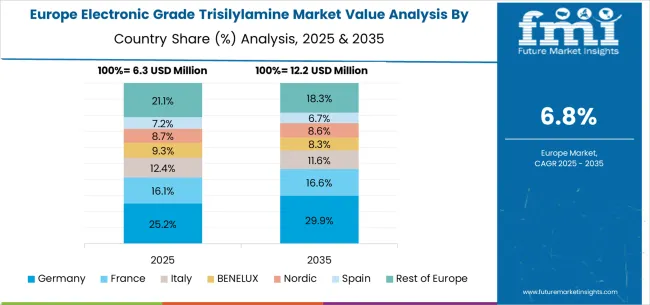
Germany maintains technology leadership through precision chemical manufacturing excellence and comprehensive semiconductor material development capabilities. The 8.6% CAGR reflects established chemical industry expertise with continuous advancement in purification technologies and quality control systems. Automotive and industrial semiconductor demand creates consistent requirements for high-performance electronic materials.
Performance Metrics:
Brazil represents emerging market growth potential with a 7.9% CAGR through expanding electronics manufacturing and government initiatives supporting domestic semiconductor ecosystem development. The market demonstrates increasing sophistication in specialty chemical applications driven by industrial development programs and foreign investment in advanced manufacturing capabilities. Regional electronics production expansion creates opportunities for specialty chemical supply chain development supporting broader Latin American market requirements.
Electronics manufacturing growth drives primary demand for specialized chemical materials across automotive electronics, consumer devices, and industrial automation applications. Government industrialization initiatives promote domestic production capabilities through technology transfer partnerships and investment incentives for advanced manufacturing operations. Regional trade agreements facilitate market access for specialty chemicals while supporting integrated supply chain development across Latin American manufacturing networks.
Strategic Market Considerations:
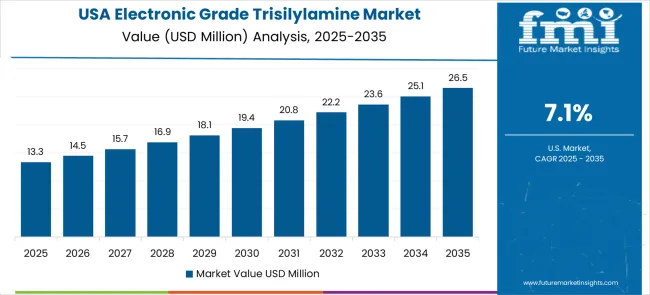
The United States demonstrates steady growth with a 7.1% CAGR through advanced semiconductor research and development initiatives coupled with domestic manufacturing reshoring programs. Silicon Valley innovation ecosystem combined with federal investment in semiconductor manufacturing, creates demand for ultra-pure specialty chemicals essential for next-generation device development. Academic research institutions and government funding programs drive continuous advancement in semiconductor material technologies.
Federal CHIPS Act investment exceeding USD 52 billion catalyzes comprehensive semiconductor manufacturing capacity development requiring sophisticated material supply chains including ultra-pure trisilylamine for advanced process applications. Manufacturing reshoring initiatives reduce supply chain dependencies while creating domestic demand for specialized precursor materials and process chemicals. Defense and aerospace applications require ultra-high purity materials for critical electronic systems and advanced technology platforms.
Market Development Focus:
The United Kingdom demonstrates focused growth with a 6.4% CAGR through specialty chemical innovation and advanced materials research excellence supported by world-class academic institutions and government innovation programs. Brexit-related industrial strategy initiatives promote domestic manufacturing capabilities while maintaining strong international research collaboration networks. Advanced materials research creates opportunities for next-generation semiconductor material development and specialized application optimization.
Academic research institutions including Cambridge and Oxford universities lead European development of advanced purification technologies and quality control systems for semiconductor applications. Government innovation funding supports specialty chemical development through Innovate UK programs and research council investments in advanced materials science. Aerospace and defense industries create a consistent demand for ultra-pure materials essential for critical electronic systems and specialized semiconductor devices.
Innovation Indicators:
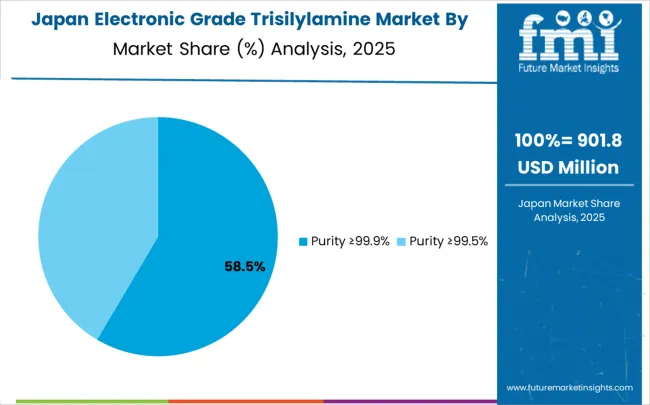
Japan maintains an established market position with a 5.6% CAGR through precision chemical manufacturing excellence and comprehensive semiconductor material technology development capabilities. Legacy semiconductor industry expertise combined with advanced materials research institutes creates consistent demand for ultra-pure specialty chemicals across multiple high-technology applications. Manufacturing precision culture drives continuous quality improvement and process optimization for specialty chemical production.
Semiconductor equipment manufacturing industry requires ultra-pure precursor materials for process validation, customer demonstrations, and technical support applications across global markets. Advanced materials research institutes, including RIKEN and the National Institute for Materials Science lead international development of next-generation purification technologies and analytical methods. Electronics manufacturing excellence spanning automotive, industrial, and consumer applications creates consistent demand for high-performance chemical materials.
Technology Leadership Aspects:
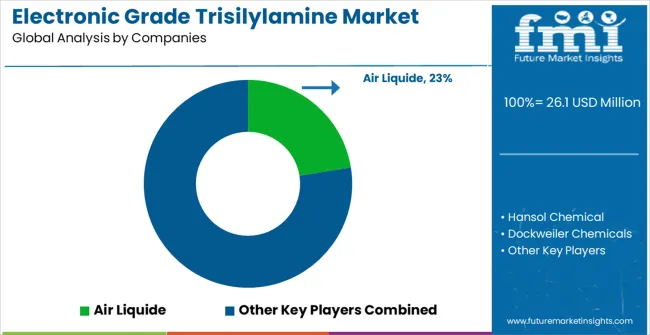
Market structure reflects high concentration with established specialty chemical manufacturers maintaining significant positions while regional suppliers serve specific geographic markets. Competition emphasizes technological innovation, quality assurance capabilities, and semiconductor industry partnership development. Industry dynamics favor companies combining advanced chemical synthesis expertise with comprehensive quality control systems and global supply chain presence.
Tier 1 - Global Specialty Chemical Leaders: Companies like Air Liquide dominate through comprehensive electronic material portfolios, global manufacturing networks, and extensive semiconductor industry relationships. Competitive advantages include proven quality systems, technical support capabilities, and integrated solution development spanning multiple semiconductor applications.
Tier 2 - Regional Chemical Providers: Organizations, including Hansol Chemical and Dockweiler Chemicals focus on specific geographic markets through specialized expertise and regional manufacturing capabilities. Competitive advantages include local market knowledge, flexible production capacity, and responsive technical support, enabling close customer relationships.
Tier 3 - Domestic Suppliers: Companies including Chinese manufacturers, serve local markets through cost-competitive solutions and specialized applications. Competitive advantages include regional supply chain advantages, flexible production scheduling, and partnership relationships with domestic semiconductor manufacturers and equipment suppliers.
| Item | Value |
|---|---|
| Quantitative Units | USD 53.7 million |
| Purity Grade | Purity ≥99.5%, Purity ≥99.9% |
| Application | CVD, ALD |
| Regions Covered | North America, Latin America, Europe, East Asia, South Asia & Pacific, Middle East & Africa |
| Countries Covered | United States, Canada, Mexico, Germany, United Kingdom, France, Italy, Spain, Nordic, BENELUX, China, Japan, South Korea, India, ASEAN, Australia, New Zealand, Brazil, Chile, Kingdom of Saudi Arabia, GCC Countries, Turkey, South Africa |
| Key Companies Profiled | Air Liquide, Hansol Chemical, Dockweiler Chemicals, Jiangsu Nata Opto-electronic Material, APK (Shanghai) Gas, China Silicon Corporation, Huate Gas, Zhejiang Borui Electronic Technology |
| Additional Attributes | Dollar sales by purity grade categories, regional demand trends across North America, Europe, and Asia-Pacific, competitive landscape analysis, adoption patterns across semiconductor sectors, integration with advanced manufacturing processes, purification technology innovations, and quality control standards |
The global electronic grade trisilylamine market is estimated to be valued at USD 26.1 million in 2025.
The market size for the electronic grade trisilylamine market is projected to reach USD 53.7 million by 2035.
The electronic grade trisilylamine market is expected to grow at a 7.5% CAGR between 2025 and 2035.
The key product types in electronic grade trisilylamine market are purity ≥99.9% and purity ≥99.5%.
In terms of application, cvd segment to command 61.2% share in the electronic grade trisilylamine market in 2025.






Our Research Products

The "Full Research Suite" delivers actionable market intel, deep dives on markets or technologies, so clients act faster, cut risk, and unlock growth.

The Leaderboard benchmarks and ranks top vendors, classifying them as Established Leaders, Leading Challengers, or Disruptors & Challengers.

Locates where complements amplify value and substitutes erode it, forecasting net impact by horizon

We deliver granular, decision-grade intel: market sizing, 5-year forecasts, pricing, adoption, usage, revenue, and operational KPIs—plus competitor tracking, regulation, and value chains—across 60 countries broadly.

Spot the shifts before they hit your P&L. We track inflection points, adoption curves, pricing moves, and ecosystem plays to show where demand is heading, why it is changing, and what to do next across high-growth markets and disruptive tech

Real-time reads of user behavior. We track shifting priorities, perceptions of today’s and next-gen services, and provider experience, then pace how fast tech moves from trial to adoption, blending buyer, consumer, and channel inputs with social signals (#WhySwitch, #UX).

Partner with our analyst team to build a custom report designed around your business priorities. From analysing market trends to assessing competitors or crafting bespoke datasets, we tailor insights to your needs.
Supplier Intelligence
Discovery & Profiling
Capacity & Footprint
Performance & Risk
Compliance & Governance
Commercial Readiness
Who Supplies Whom
Scorecards & Shortlists
Playbooks & Docs
Category Intelligence
Definition & Scope
Demand & Use Cases
Cost Drivers
Market Structure
Supply Chain Map
Trade & Policy
Operating Norms
Deliverables
Buyer Intelligence
Account Basics
Spend & Scope
Procurement Model
Vendor Requirements
Terms & Policies
Entry Strategy
Pain Points & Triggers
Outputs
Pricing Analysis
Benchmarks
Trends
Should-Cost
Indexation
Landed Cost
Commercial Terms
Deliverables
Brand Analysis
Positioning & Value Prop
Share & Presence
Customer Evidence
Go-to-Market
Digital & Reputation
Compliance & Trust
KPIs & Gaps
Outputs
Full Research Suite comprises of:
Market outlook & trends analysis
Interviews & case studies
Strategic recommendations
Vendor profiles & capabilities analysis
5-year forecasts
8 regions and 60+ country-level data splits
Market segment data splits
12 months of continuous data updates
DELIVERED AS:
PDF EXCEL ONLINE
Electronic Circulation Pump Market Size and Share Forecast Outlook 2025 to 2035
Electronic Lab Notebook (ELN) Market Size and Share Forecast Outlook 2025 to 2035
Electronic Control Unit in Automotive Systems Market Size and Share Forecast Outlook 2025 to 2035
Electronic Film Market Size and Share Forecast Outlook 2025 to 2035
Electronic Weighing Scale Market Size and Share Forecast Outlook 2025 to 2035
Electronic Packaging Adhesives Market Forecast and Outlook 2025 to 2035
Electronic Sealants Market Size and Share Forecast Outlook 2025 to 2035
Electronic Nasal Spray Devices Market Size and Share Forecast Outlook 2025 to 2035
Electronic Expansion Valves Market Size and Share Forecast Outlook 2025 to 2035
Electronics Adhesives Market Size and Share Forecast Outlook 2025 to 2035
Electronic Tactile Tester Market Size and Share Forecast Outlook 2025 to 2035
Electronic Trial Master File (eTMF) System Market Size and Share Forecast Outlook 2025 to 2035
Electronic Wipes Market Size and Share Forecast Outlook 2025 to 2035
Electronically Scanned Arrays System Market Size and Share Forecast Outlook 2025 to 2035
Electronics Retailing Market Size and Share Forecast Outlook 2025 to 2035
Electronic Dictionary Market Size and Share Forecast Outlook 2025 to 2035
Electronic Shelf Label Market Analysis - Size, Share, and Forecast Outlook 2025 to 2035
Electronics Films Market Size and Share Forecast Outlook 2025 to 2035
Electronic Payment System For Transportation Market Size and Share Forecast Outlook 2025 to 2035
Electronic Skin Market Analysis - Size, Share, and Forecast Outlook 2025 to 2035

Thank you!
You will receive an email from our Business Development Manager. Please be sure to check your SPAM/JUNK folder too.
Chat With
MaRIA